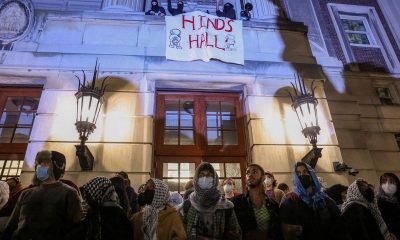Economy
Column-Hawkish Fed unwittingly stokes Treasuries ‘basis trade’ risks: McGeever


By Jamie McGeever
ORLANDO, Florida (Reuters) – The Federal Reserve’s hawkish stance on interest rates, and determination to reduce its balance sheet, may inadvertently be stoking financial stability risks by encouraging hedge funds to extend or even increase their “basis trade” bets in the U.S. bond market.
The trade – a leveraged arbitrage play profiting from the price difference between cash bonds and futures – has exploded since the Fed began tightening policy last year, to such a degree that central banks and regulators are now closely monitoring.
The Bank for International Settlements warned this month that the huge build-up in speculators’ short Treasuries position “is a financial vulnerability worth monitoring because of the margin spirals it could potentially trigger.”
A Fed paper on Aug. 30 noted that if these positions represent the so-called basis trades, “sustained large exposures by hedge funds present a financial stability vulnerability” warranting “continued and diligent monitoring.”
The trade is often more profitable in an environment of rising and elevated interest rates. The higher rates stay, the longer funds hold the position and the longer a potentially disruptive unwind is put off.
Crucially, though, it also needs stable funding conditions, ample liquidity and relatively low or steady volatility. A “higher-for-longer” steady Fed might tame inflation, but at some point increases the risk of financial shocks.
Policymakers hope tighter money gradually lets the air out of this and other balloons rather than bursting them. Sudden and large reversals in prices or policy rates are undesirable. It is a delicate balance.
As long as rates and yields are manageable, overall liquidity is ample, and funding conditions in the Treasury repurchase market remain favorable, there is every incentive for funds to hold the position.
These stars are still in alignment.
“As QT (quantitative tightening) continues and more liquidity gets drained out of the system, repo rates will move higher, funding will get tighter, and conditions for long-basis positions will become less favorable,” says Steven Zeng, a strategist at Deutsche Bank.
“But we’re not there yet. We’ll perhaps start to see funding pressure develop around the middle of next year,” he reckons.
NICKELS & STEAMROLLER
Estimating the size of hedge funds’ basis trade bets is difficult because transparency and visibility around hedge funds is so low at the best of times, especially with regard to their more complex activities and strategies.
Many analysts look at leveraged funds’ position in Treasuries futures, and the Aug. 30 Fed paper also noted speculators’ repo borrowings.
Hedge funds’ repo borrowing via the Fixed Income Clearing Corporation’s centrally-cleared bilateral repo market more than doubled to a historically high $233 billion between October 2022 and May of this year. This is a fairly reliable sign of basis trade activity, the Aug. 30 Fed paper says.
Overnight repo rates have steadily tracked the fed funds policy rate since March 2022. There has been none of the volatility and price spikes of 2019 or early 2020.
Commodity Futures Trading Commission figures, meanwhile, show that leveraged funds have amassed a huge net short position in two-, five- and 10-year Treasuries futures worth around $700 billion, a position matched by asset managers on the other side.
Worryingly for regulators, funds’ short positions are approaching the previous record in 2019. They are already bigger than early March 2020 when the coronavirus pandemic shut down the economy, a wave of volatility crashed over the U.S. bond market, and the Fed slashed rates to the near-zero level and launched unlimited, open-ended large-scale asset purchases.
Basis trade liquidation, as funds got squeezed out of their positions through margin and collateral calls as volatility rocketed, likely contributed to that dislocation.
It’s impossible to quantify the impact this unwind had, but the ‘s volatility at the time is worth noting: it fell 100 basis points between Feb. 20 and March 9, rebounded 75 basis points over the next nine days, then slumped 65 basis points by the end of the month.
Avoiding a repeat and ensuring as smooth an unwind as possible this time around, whenever it comes, will be crucial to the functioning of the world’s most important financial market.
Christoph Schon, senior principal for applied research at Axioma, says that if the Fed keeps rates around their current level for the next nine months, as rates markets currently indicate, the basis trade balloon will continue to expand.
Asset managers will see strong client demand from investors looking to lock in the highest yields since before the global financial crisis, and hedge funds will “scramble to pick up the nickels in front of the basis trade steamroller.”
(The opinions expressed here are those of the author, a columnist for Reuters)
(By Jamie McGeever; Editing by Paul Simao)
Economy
Russian central bank says it needs months to make sure CPI falling before rate cuts -RBC


© Reuters. Russian Central Bank Governor Elvira Nabiullina attends a news conference in Moscow, Russia June 14, 2019. REUTERS/Shamil Zhumatov/File Photo
MOSCOW (Reuters) – Russia’s central bank will need two to three months to make sure that inflation is steadily declining before taking any decision on interest rate cuts, the bank’s governor Elvira Nabiullina told RBC media on Sunday.
The central bank raised its key interest rate by 100 basis points to 16% earlier in December, hiking for the fifth consecutive meeting in response to stubborn inflation, and suggested that its tightening cycle was nearly over.
Nabiullina said it was not yet clear when exactly the regulator would start cutting rates, however.
“We really need to make sure that inflation is steadily decreasing, that these are not one-off factors that can affect the rate of price growth in a particular month,” she said.
Nabiullina said the bank was taking into account a wide range of indicators but primarily those that “characterize the stability of inflation”.
“This will take two or three months or more – it depends on how much the wide range of indicators that characterize sustainable inflation declines,” she said.
The bank will next convene to set its benchmark rate on Feb. 16.
The governor also said the bank should have started monetary policy tightening earlier than in July, when it embarked on the rate-hiking cycle.
Economy
China identifies second set of projects in $140 billion spending plan


© Reuters. FILE PHOTO: Workers walk past an under-construction area with completed office towers in the background, in Shenzhen’s Qianhai new district, Guangdong province, China August 25, 2023. REUTERS/David Kirton/File Photo
SHANGHAI (Reuters) – China’s top planning body said on Saturday it had identified a second batch of public investment projects, including flood control and disaster relief programmes, under a bond issuance and investment plan announced in October to boost the economy.
With the latest tranche, China has now earmarked more than 800 billion yuan of its 1 trillion yuan ($140 billion) in additional government bond issuance in the fourth quarter, as it focuses on fiscal steps to shore up the flagging economy.
The National Development and Reform Commission (NDRC) said in a statement on Saturday it had identified 9,600 projects with planned investment of more than 560 billion yuan.
China’s economy, the world’s second largest, is struggling to regain its footing post-COVID-19 as policymakers grapple with tepid consumer demand, weak exports, falling foreign investment and a deepening real estate crisis.
The 1 trillion yuan in additional bond issuance will widen China’s 2023 budget deficit ratio to around 3.8 percent from 3 percent, the state-run Xinhua news agency has said.
“Construction of the projects will improve China’s flood control system, emergency response mechanism and disaster relief capabilities, and better protect people’s lives and property, so it is very significant,” the NDRC said.
The agency said it will coordinate with other government bodies to make sure that funds are allocated speedily for investment and that high standards of quality are maintained in project construction.
($1 = 7.1315 renminbi)
Economy
Russian central bank says it needs months to make sure CPI falling before rate cuts -RBC


© Reuters. Russian Central Bank Governor Elvira Nabiullina attends a news conference in Moscow, Russia June 14, 2019. REUTERS/Shamil Zhumatov/File Photo
MOSCOW (Reuters) – Russia’s central bank will need two to three months to make sure that inflation is steadily declining before taking any decision on interest rate cuts, the bank’s governor Elvira Nabiullina told RBC media on Sunday.
The central bank raised its key interest rate by 100 basis points to 16% earlier in December, hiking for the fifth consecutive meeting in response to stubborn inflation, and suggested that its tightening cycle was nearly over.
Nabiullina said it was not yet clear when exactly the regulator would start cutting rates, however.
“We really need to make sure that inflation is steadily decreasing, that these are not one-off factors that can affect the rate of price growth in a particular month,” she said.
Nabiullina said the bank was taking into account a wide range of indicators but primarily those that “characterize the stability of inflation”.
“This will take two or three months or more – it depends on how much the wide range of indicators that characterize sustainable inflation declines,” she said.
The bank will next convene to set its benchmark rate on Feb. 16.
The governor also said the bank should have started monetary policy tightening earlier than in July, when it embarked on the rate-hiking cycle.

 Forex2 years ago
Forex2 years agoForex Today: the dollar is gaining strength amid gloomy sentiment at the start of the Fed’s week

 Forex2 years ago
Forex2 years agoHow is the Australian dollar doing today?

 Forex1 year ago
Forex1 year agoUnbiased review of Pocket Option broker

 Forex2 years ago
Forex2 years agoDollar to pound sterling exchange rate today: Pound plummeted to its lowest since 1985

 Cryptocurrency2 years ago
Cryptocurrency2 years agoWhat happened in the crypto market – current events today

 World2 years ago
World2 years agoWhy are modern video games an art form?

 Stock Markets2 years ago
Stock Markets2 years agoMorgan Stanley: bear market rally to continue

 Economy2 years ago
Economy2 years agoCrude oil tankers double in price due to EU anti-Russian sanctions

































